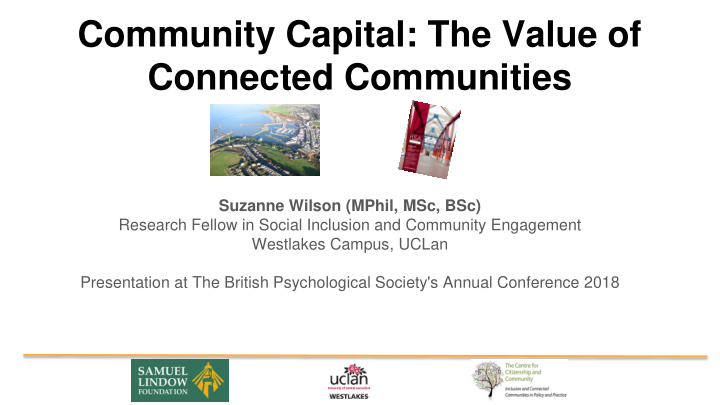



Community Capital: The Value of Connected Communities Suzanne Wilson (MPhil, MSc, BSc) Research Fellow in Social Inclusion and Community Engagement Westlakes Campus, UCLan Presentation at The British Psychological Society's Annual Conference 2018
Contents Connected Communities - Theory of Change - Connected Communities approach - Community Capital: Social Dividends Connected Communities West Cumbria - Overview of West Cumbria - Connected Communities: Application in West Cumbria
Connected Communities Action research project to explore how the community dimension of people’s lives contributes to well-being and can be developed to analyse how different interventions build resilient, inclusive communities and empower individuals to take greater control of their lives through relationships based on shared concerns and mutual trust.
Centre for Citizenship and Community - who are we? UCLan – research, evaluation, community engagement, courses Associate team – health, social care and public services – senior experience in health, social care and public service sectors – commissioning, management, strategy, housing, leadership, service improvement design.. RSA Connected Communities team – action research, network analysis, policy development, thought leadership and organisational change supported by a multi- disciplinary network drawn from RSA’s Fellowship. Personal Social Services Research Unit (London School of Economics) – extensive expertise in social services and health research, economic modelling; financial analysis.
Centre for Citizenship and Community – our key principles Change through networks Imaginative community networks are key to social action and new approaches to governance at all levels* Social value capture Community engagement is imperative to local empowerment and to unlocking the social value – the unseen assets – of community Organising for inter-dependence Building from ‘the multiple practices of reciprocity’ (Taylor); public services/communities; bonding and bridging communities; individuals and social networks A culture of co-production Public service organisations with a ‘literacy of community’, ‘complexity–capable’ co -production: design, development and delivery = innovation (*SeeTapscott, RSA Journal Spring 2013)
Research portfolio 2015 -17 (since conclusion of Connected Communities programme) 1. ODESSA: 3 year international study on ageing in place with China and France (ESRC); 2. ‘Supports for Success’: Connected Communities input to Young people in communities programme through Wellesley Institute (Ontario Govt., funded think tank) and Toronto PH. (State Govt., pending); 3. Connecting People study, with University of York, (NIHR, SCC); Housing and Community in Foleshill, Coventry: CC programme with Orbit Housing to enable housing – 4. led community engagement . 5. Developing community capacity through a Connected Communities approach in Preston, (LA): 6. ‘Connected Street Associations ’ SAs; developing evidence base for SA’s, Kingstanding, Birmingham (BC?CCG) 7. Community Connectors, with Solent MIND, developing a MH community connectors programme Hants(LA); 8. Development partnership, Building Bridges, Community Cohesion project Pendle, NW England (BL,pending) 9. Development Support for ‘Community Conversations’ in 12 - 15 People’s Health Trust sites (PHT). 10. Empowering citizenship in young people: intergenerational citizenship in West Cumbria. 11. Evaluation of national MH and Adult Learning pilots with Ipsos MORI (Central Govt: BIS); 12. Prevention and Community Resilience: evaluating older people’s community funded services, Kirklees (LA); 13. Personalisation : assessment of integrated approach to uptake (MIND); 14. Establishing Connected Communities based care pathway for people with LTCs , N. Manchester (CCG)
Theory of change: Understand, Involve, Connect We suggest that community capital can be grown through a way of working that follows the Connected Communities principles of Understanding the local situation, relationships and patterns of isolation, Involving people in creating a solution, and aiming to Connect people to one another to reduce isolation and create more connected communities.
Connected Communities Methodology Steering Identify Key Recruit Community Research Groups Gatekeepers Researchers Training Research Design Community Data Evaluation Co-production Feedback Collection
A wellbeing dividend
An economic dividend
A citizenship dividend
A capacity dividend
Connected Communities West Cumbria
An overview of West Cumbria Geographically isolated Post industrial area with Sellafield being a major employer Polarised social demography Pockets of very high deprivation Limited services Below regional and national averages of educational and employment
Connected Communities Methodology: Application in West Cumbria Community Identify key Community engagement gatekeepers Steering researcher with young working with Groups training people young people Research Data Collection Design
INDIVIDUAL IMPACT Improved well-being: Outcomes star (Quantitative) Improved educational performance: Attainment data and Attendance data (Quantitative) Enhanced Community Capital (Individual Level): Teacher survey (Mixed), Parent survey (Mixed) Young person’s interviews (Qualitative) COMMUNITY IMPACT Enhanced Community Capital (Community Level): Improved capacity: Outcomes star/ Focus groups/ Interviews (Mixed) Improved citizenship: Outcomes star/ Focus groups/ Interviews (Mixed) Improved well-being: Outcomes star/ Focus groups/ Interviews (Mixed) Socio-economic savings: Social value? Quantitative POLICY IMPACT Evidence from councillors: Statements, examples of policies impacted upon by work (Mixed) Evidence from presentations at meetings: Photos, statements, frequency of presentations (Mixed)
Identify key gatekeepers working with young people Background Photo of Emma and Mark
Strong partnership working • Shared values • Clear roles • Clear expectations • Honesty • Planning and debrief • Agreed Communications
Community engagement with young people
Research Design • Social network analysis • Survey administration practice • Survey content feedback • Revised survey practice
Data Collection • Based in community centres • Took place during Easter holidays, 4 days per community • Supported by police officers and PCSOs • Participation rate: • Response rate:
Next Steps • Complete data collection INDIVIDUAL • IMPACT Data analysis • Community playback COMMUNITY IMPACT • Co-production • Roll out POLICY IMPACT • Evaluation
Implications Combined, these strands of research aim to compare and contrast ways of partnership working in projects aiming to promote youth citizenship , informing future research, policy and practice. Results will complement existing research on the role of different gatekeepers in engaging and researching with less traditional sample populations. Findings can add to the current literature on participant led research with young people, providing case studies publishable in peer reviewed journals. Best practice can be developed and incorporated on a local and national level though overcoming social challenges and promoting citizenship and engagement .
Thank you for your time. Any questions? swilson21@uclan.ac.uk 01946 517226 07929266679
Recommend
More recommend